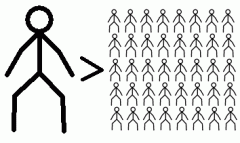Nonprofit Marketing: The Power of Personalization
 Logic tells us that a bigger problem should get more attention. One person suffering from a disease is certainly bad, but a thousand afflicted individuals should motivate us far more. As is often the case in our odd world of neuromarketing and neuroeconomics, research shows that our brains operate in an illogical and perhaps unexpected manner. Paul Slovic, a researcher at Decision Research, has demonstrating this by measuring the contribution levels from people shown pictures of starving children. Some subjects were shown a photo of a single starving child from Mali, others were shown a photo of two children. All were identified by name. The subjects shown two children donated 15% less than the single child subjects. In a related experiment, subjects shown a group of eight starving children contributed 50% less money than those shown just one.
Logic tells us that a bigger problem should get more attention. One person suffering from a disease is certainly bad, but a thousand afflicted individuals should motivate us far more. As is often the case in our odd world of neuromarketing and neuroeconomics, research shows that our brains operate in an illogical and perhaps unexpected manner. Paul Slovic, a researcher at Decision Research, has demonstrating this by measuring the contribution levels from people shown pictures of starving children. Some subjects were shown a photo of a single starving child from Mali, others were shown a photo of two children. All were identified by name. The subjects shown two children donated 15% less than the single child subjects. In a related experiment, subjects shown a group of eight starving children contributed 50% less money than those shown just one.
Slovic suspects this stuff is hardwired. Psychologists have long observed that our ability to discriminate among quantities is finely tuned when dealing with small amounts but quickly degrades as the numbers get larger. Our ears work that way, too. When a very quiet sound becomes slightly louder, we detect the difference right away. But once a noise is really loud, it has to increase dramatically for it to seem “louder.” The same holds true for our judgments of weight and, of course, less tangible quantities like money. [From WIRED: Clive Thompson Explains Why We Can Count on Geeks to Rescue the Earth.]
As Thompson aptly puts it, “We’ll break the bank to save Baby Jessica, but when half of Africa is dying, we’re buying iPhones.” Clearly, non-profit marketers need to make their marketing efforts as personal as possible – and not just on the donor side, but on the recipient side as well. This is real “one-to-one” marketing.
No charity understands the concept better than the Christian Children’s Fund, who lets its donors sponsor a single child identified by name, photo, and other personal details. Potential donors are presented with a photo and biography of a child they can sponsor for a mere 80 cents a day. The description begins, “Sindy is a pretty little girl who lives in a poor rural community located on the western part of Honduras, Central America. She stays healthy most of the time and has no physical impediments. Sindy attends preschool. She likes drawing and playing with dolls…” and is accompanied by a photo that shows a needy but not pathetic child. And, if you aren’t moved to save that particular child from abject poverty, you can click a link for “Search for a different child” that lets you see several new child photos and also lets you search by gender, age, etc. in case you have a preference. The potential donor can project his or her own needs onto a seemingly limitless database of needy children, browsing them until the perfect match comes up.
I’m not diminishing the great work CCF does – I was a donor for many years myself. But this is absolutely brilliant marketing. (How good? I’d bet that at least one tight-fisted marketer reading this post ends up signing up to sponsor a child.) Their superb marketing approach, which we now find has a sound basis in behavioral research, helps explain why CCF has been around for nearly seventy years and, according to their website, has helped more than 13 million children. (Another nifty element of their personalized recipient approach is that most donors no doubt feel obligated to keep giving – even if you cut back donations to other charities, do you really want to imagine your child being tossed back into a life of grinding poverty because you wanted to make a few more Starbucks visits each month? I’m sure CCF doesn’t actually do that, but I’d also guess their donor continuity numbers are off the charts compared to other charities.)
Most nonprofits can benefit from a more personal approach to describing the recipients of their largesse. Don’t contribute to the Symphony’s general fund, sponsor a cellist. Don’t just write a check to the university you graduated from, provide an incoming freshman with the aid she needs to enable her to attend. Many non-profits have discovered the power of personalizing their appeal already, but others still inundate potential owners with mind-numbing statistics.
The point of Thompson’s article was that it takes a numbers guy like Bill Gates to understand the big numbers of disease and malnutrition. Nonprofit marketers would do well to remember that the vast majority of their donors aren’t adept at converting statistics into a donation strategy, and that our brains are wired to respond more strongly to an individual plight than the same condition afflicting a group. Appeals personalized for individual donors have always been important in raising money, but personalizing the recipients can be just as important.
